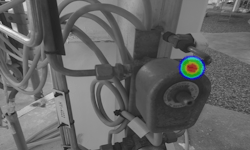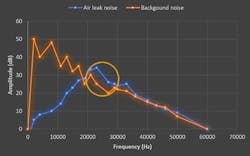Compressed air leak detection for oil and gas organizations
For oil and gas organizations from extractors to refiners, compressed air plays a crucial role along the production chain: upstream, midstream or downstream. Upstream, exploration and producing organizations rely on compressed air for a variety of mission-critical tasks from drilling to well testing. Midstream, compressed air is vital to the effective transportation and storage of oil and gas material as part of gas compressor systems. Downstream, refineries and petrochemical plants that process hydrocarbon material may use modulating-screw air compressors to help produce a multitude of distillates.
Therefore, maintaining efficient and reliable air compressor systems can play an outsized role in reducing utility costs, overhead and capital expenditures that may hurt profitability and environmental, safety and governance (ESG) benchmarks. In turn, those inefficiencies, much like undetected fugitive gas emissions, can lead to increased pressure from a diverse set of stakeholders including investors, partners, customers and the local communities where an organization operates.
In response, one of the easiest and most effective ways to improve air compressor system efficiency is to develop a leak detection and remediation program. According to the Compressed Air and Gas Institute (CAGI), a compressed air line with the combined leak equivalent of only a single quarter-inch diameter hole can cost up to $8,000 USD per year in wasted electricity costs alone. Consequently, leak detection and remediation can generate material savings with added benefits of improving operational efficiency and safety while reducing overall carbon output.
Compounding problems caused by compressed air leaks
In addition to generating unnecessary utility expenditures, compressed air leaks can play a role in contributing to operational problems, especially fluctuating system pressure, which can cause equipment to function less efficiently — ultimately affecting production or processes while compounding other issues down the line. These unknown or undetected leaks may lead organizations to purchase additional compressor capacity or equipment that may be unnecessary, needlessly increasing capital expenditures. For existing equipment, leaks can lead to increased maintenance requirements, thus more expenses, from unnecessary cycling and increased run time that ultimately decreases the equipment’s respective service life.
These issues were verified in a study conducted by the United States Office of Energy Efficiency & Renewable Energy at a downstream chemical plant. Following a compressed air audit, plant operators discovered they could significantly lower operating costs by tens of thousands of dollars annually through leak remediation efforts alone. By fixing just the 10 largest leaks in a single plant, operators could achieve 70% of the overall available cost savings.
Compressed air leak detection and remediation programs
To assist oil, gas and other associated businesses in creating a compressed air leak detection program that aligns with best practices and policies, organizations can adopt ISO 50001 energy management standards. This program includes guidance on targets and objectives to meet the standards, including the use of data to better understand and make decisions about energy use, and best practices for measuring results and reviewing progress as part of continuously improving energy management.
When organizations decide to implement these standards, they are empowered to take meaningful steps to improve energy efficiency through compressed air leak detection and remediation, ultimately gaining a framework to show meaningful progress to stakeholders from regulators to investors to employees.
Improved leak detection through high-definition acoustic imaging
Whether an organization plans to implement ISO 50001 or simply wants to improve operational efficiency, identifying compressed air leaks is a good first step. While locating leaks in noisy refining facilities or far-off exploration sites can be challenging, emerging technology such as high-definition (HD) acoustic imaging devices are making compressed air leak detection easier and more accessible without requiring significant time and investment in training personnel.
HD acoustic imaging devices are comprised of a cluster of specialized, integrated microphones, providing the fastest, most convenient, and usually the most accurate method for detecting compressed air leaks. Typically, such devices feature dozens of small MEMS (micro-electromechanical system) microphones, which consume minimal power and provide optimal performance and stability.
Acoustic data is transposed in real time on top of a digital camera image, allowing for pinpoint accuracy of the sound source. The system itself is AI-enabled to distinguish the ultrasonic signal generated by compressed gas leaks even in extremely noisy industrial environments.
The tools include convenient transfer of saved images via WiFi from onboard memory to a cloud storage system for web-based analysis, leak quantification and reporting, or regular USB download of images to a desktop software package. The camera itself can also provide real-time leak flow estimates to help operators prioritize which leaks to remedy first. After all, the larger the leak, the larger the incurred costs and potential for process disruption.
Furthermore, some handheld devices only require one hand to operate and can quickly scan large areas from a safe distance, often more than 100 meters away, for safer problem detection and analysis, without the need to physically touch or shut down machinery.
The best tool — HD acoustic imaging
Although HD acoustic imaging provides the best balance of ease of use, effectiveness and accuracy, it also comes with the highest upfront costs compared to other decidedly low-tech methods. Traditional soap-bubble tests can be effective at a fraction of the cost, but it will only tell inspectors where a leak is located — not how much is leaking — assuming the inspector even knows where to look. Furthermore, this test requires a certain amount of pressure within the system to be effective while potentially putting inspectors in danger.
Regardless of the method, preventative leak detection represents a relatively fast and simple way for organizations to reduce energy consumption and enjoy the requisite cost and safety improvements. Oil and gas organizations may also discover they do not need to completely overhaul processes, immediately replace expensive equipment or purchase additional capacity that is otherwise unnecessary.
Rob Milner, Professional Engineer, has worked in a sales and business development role for FLIR, now Teledyne FLIR, for over 20 years, with experience in most of FLIR’s market verticals. He applies this experience to ensure FLIR customers receive accurate advice centered around their needs. Milner has a Bachelor of Science and Master of Science in metallurgical engineering.
Teledyne FLIR
About the Author
Rob Milner
Rob Milner, Professional Engineer, has worked in a sales and business development role for FLIR, now Teledyne FLIR, for over 20 years, with experience in most of FLIR’s market verticals. He applies this experience to ensure FLIR customers receive accurate advice centered around their needs. Milner has a Bachelor of Science and Master of Science in metallurgical engineering.

